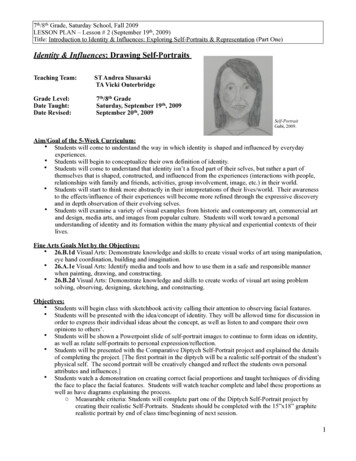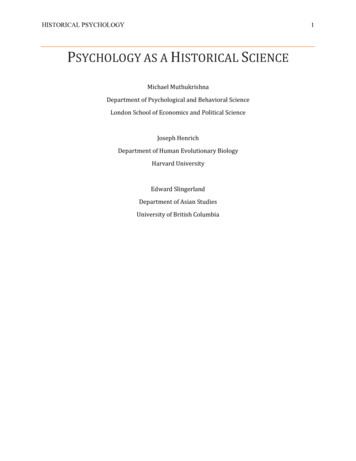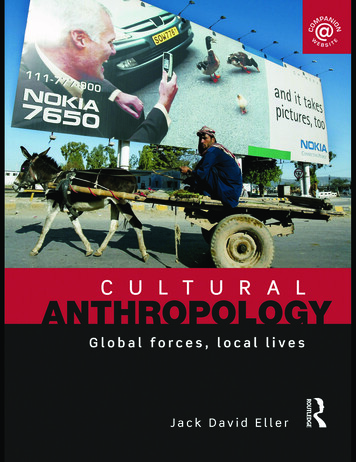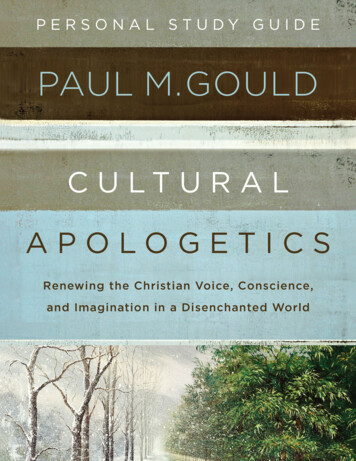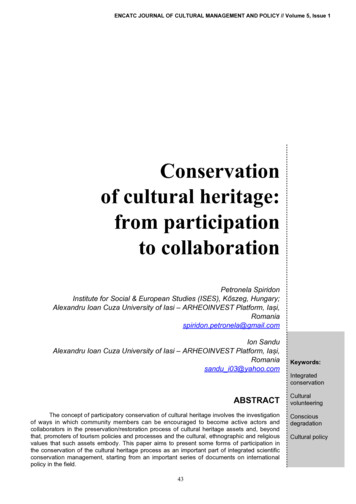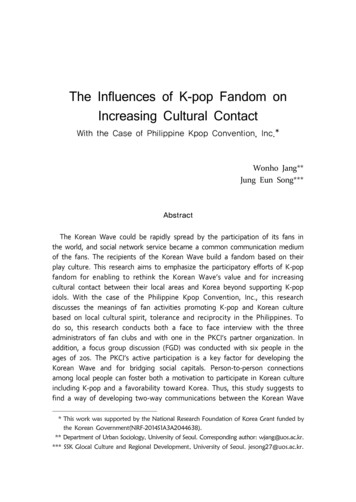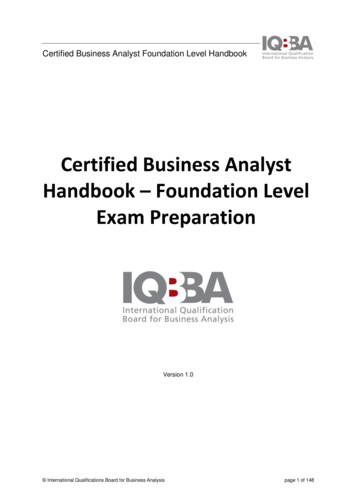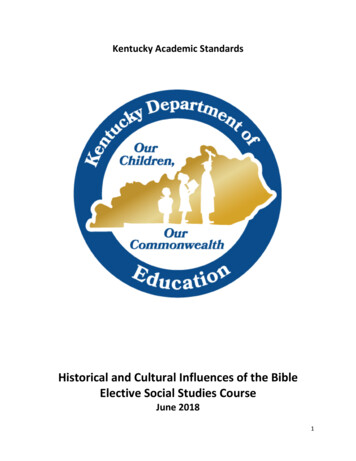
Transcription
Kentucky Academic StandardsHistorical and Cultural Influences of the BibleElective Social Studies CourseJune 20181
TABLE OF Kentucky’s Vision for Students3Legal Basis5WRITERS’ VISION STATEMENT6Design Considerations7STANDARDS USE AND DEVELOPMENT7Standards Are Not Curriculum7Translating Standards into Curriculum7Organization of Standards7Supplementary Materials to the Standards10KENTUCKY ACADEMIC STANDARDS: THE HISTORICAL AND CULTURAL INFLUENCES OF THE BIBLEELECTIVE SOCIAL STUDIES COURSE12Appendix A: Disciplinary Connections13Appendix B: Glossary of Terms17Appendix C: Writing and Review Committees182
Kentucky Academic StandardsHistorical and Cultural Influences of the Bible Elective Social Studies CourseINTRODUCTIONBackgroundTeaching about religion in public schools is often controversial and complex. In 1963, the U.S.Supreme Court ruled daily Bible readings and prayer in public schools were unconstitutional,but the same Court ruling allowed religion in public school curriculum. While public schoolscannot promote a religion, the Court said students may be taught about religion including itsrole in history and literature.Religion plays a significant role in history and society. The National Council for the Social Studies(NCSS) affirms that study about religions is an essential component of social studies scholarship.Knowledge about religions is necessary for active and informed citizenship. It develops culturalliteracy, helps dispel stereotypes, supports cross-cultural understandings and encouragesrespect for the rights of others to religious liberty.ConstitutionalityThe First Amendment to the U.S. Constitution prohibits the "establishment" of religion by thegovernment and precludes the government from becoming "entangled" in religion. That is,government shall neither endorse nor prohibit the free exercise of any religion. For example,the government may not forbid students from privately praying; however, the government isnot to sponsor group prayer, as that may be an endorsement of a particular religion.Similarly, excerpts from the Bible may be read in the context of a world history or literaturecourse. Likewise, the tenets of various religions may be covered in a comparative religioncourse. However, these activities only can be done as long as there is no “establishment” orendorsement of a particular religion by the school. It is important to note these requirementsdo not apply to private or parochial schools.Kentucky’s Vision for StudentsKnowledge about religion develops skills and dispositions (e.g., cultural literacy, respect forrights of others) that directly align with the Kentucky Board of Education’s vision that each andevery student is empowered and equipped to pursue a successful future. To equip andempower students, the following capacity and goal statements frame instructional programs inKentucky schools. They were established by the Kentucky Education Reform Act (KERA) of 1990,as found in Kentucky Revised Statute (KRS) 158.645 and KRS 158.6451. All students shall havethe opportunity to acquire the following capacities and learning goals: Communication skills necessary to function in a complex and changing civilization; Knowledge to make economic, social and political choices; Core values and qualities of good character to make moral and ethical decisionsthroughout his or her life; Understanding of governmental processes as they affect the community, the state and3
the nation;Sufficient self-knowledge and knowledge of his or her mental health and physicalwellness;Sufficient grounding in the arts to enable each student to appreciate his or her culturaland historical heritage;Sufficient preparation to choose and pursue his or her life’s work intelligently; andSkills to enable him or her to compete favorably with students in other states.Furthermore, schools shall: Expect a high level of achievement from all students. Develop their students’ abilities to:oUse basic communication and mathematics skills for purposes and situationsthey will encounter throughout their lives;oApply core concepts and principles from mathematics, the sciences, the arts, thehumanities, social studies and practical living studies to situations they willencounter throughout their lives;oBecome self-sufficient individuals of good character exhibiting the qualities ofaltruism, citizenship, courtesy, hard work, honesty, human worth, justice,knowledge, patriotism, respect, responsibility and self-discipline;oBecome responsible members of a family, work group or community, includingdemonstrating effectiveness in community service;oThink and solve problems in school situations and in a variety of situations theywill encounter in life;oConnect and integrate experiences and new knowledge from all subject matterfields with what they have previously learned and build on past learningexperiences to acquire new information through various media sources; andoExpress their creative talents and interests in visual arts, music, dance anddramatic arts. Increase student attendance rates; Increase their students' graduation rates and reduce their students' dropout andretention rates; Reduce physical and mental health barriers to learning; and Be measured on the proportion of students who make a successful transition to work,postsecondary education and the military.Kentucky law establishes minimum requirements for all students to earn a diploma. Localschools and districts, however, have authority over elective courses offered in the school ordistrict. House Bill (HB) 128 (2017) requires the KBE to promulgate academic standards forelective courses for high schools based on the Hebrew Scriptures, Old Testament of the Bible,the New Testament of the Bible, and/or Hebrew Scriptures and the New Testament of theBible. The bill also states that any course created shall follow applicable law and all federal andstate guidelines in maintaining religious neutrality and accommodating the diverse religiousviews, traditions and perspectives of students in a school. A course under this section shall notendorse, favor or promote or disfavor or show hostility toward any particular religion or4
nonreligious faith or religious perspective. Teachers who teach this elective course must becertified to teach high school social studies.Prior to HB 128, it was permissible for Kentucky public schools to offer elective courses focusedon the study of the Bible and other religious texts, provided instruction did not promote oradvocate any religion or its beliefs over another, and it was focused on analysis of the literary,cultural or historical influences of these texts. These elective courses were offered based ondecisions of local districts and schools. Schools also have offered Bible literacy courses in thepast as English/language arts electives.To ensure legal requirements of these courses are met, the Kentucky Department of Education(KDE) encourages schools to use the Model Curriculum Framework to inform development ofcurricula related to these courses. The Model Curriculum Framework encourages putting thestudent at the center of planning to ensure that the goal of such a curriculum is to produce students that are ethical citizens in ademocratic global society and to help them become self-sufficient individuals who areprepared to succeed in an ever-changing and diverse world. Design and implementationrequires professionals to accommodate the needs of each student and focus onsupporting the development of the whole child so that all students have equitableaccess to opportunities and support for maximum academic, emotional, social andphysical development.(Model Curriculum Framework, page 19)Legal BasisThe following Kentucky Revised Statutes (KRS) and Kentucky Administrative Regulations (KAR)provide a legal basis for this publication:KRS 156.160 Promulgation of administrative regulations by the Kentucky Board of EducationWith the advice of the Local Superintendents Advisory Council (LSAC), the KBE shallpromulgate administrative regulations establishing standards that public school districtsshall meet in student, program, service and operational performance. These regulationsshall comply with the expected outcomes for students and schools set forth in KRS158:6451.KRS 156.162 Elective course on religious scripture -- Purpose -- Restrictions -- Inclusion ofcourse standards in program of studiesRequires the Kentucky Board of Education to promulgate administrative regulation thatsets forth the required and elective courses for the schools shall include: (a) An electivesocial studies course on the Hebrew Scriptures, Old Testament of the Bible; (b) Anelective social studies course on the New Testament of the Bible; or (c) An elective socialstudies course on the Hebrew Scriptures and the New Testament of the Bible.5
KRS 158.197 Elective course on religious scripture – Purpose – Restrictions -- School council orgoverning body authorized to display historical and nonreligious artifacts, monuments,symbols and texts in conjunction with course of studyPermits a School-Based Decision Making Council (SBDM) to offer an elective high schoolsocial studies course and required the KDE to develop course standards on the HebrewScriptures, Old Testament of the Bible, the New Testament or a combination of theHebrew Scriptures and the New Testament of the Bible.704 KAR 3:306 Kentucky Academic Standards for Historical and Cultural Influences of theBible Elective Social Studies CourseAdopts into law the Kentucky Academic Standards for Historical and Cultural Influencesof the Bible Elective Social Studies Course. The purpose of these courses is to focus onthe historical impact and literary style from texts of the Old Testament and/or NewTestament, including the Hebrew Scriptures, to teach students knowledge of biblicalcontent, characters, poetry and narratives that are prerequisites to understandingcontemporary society and culture, including literature, art, music, mores, oratory andpublic policy.A course offered under this section shall follow all applicable laws and federal and stateguidelines in maintaining religious neutrality and accommodating the diverse religiousviews, traditions and perspectives of students in the school. A course under this sectionshall not endorse, favor, promote, disfavor or show hostility toward any particularreligion, non- religious faith or religious perspective. Pursuant to KRS 158.197, a SchoolBased Decision Making (SBDM) council may offer this course to students in grade 9 orabove.WRITERS’ VISION STATEMENTThe writing team was composed of four teachers selected from a pool of approximately thirtyapplicants. The team was selected based on their expertise in the area of social studies,including a specialty in the study of religions. The selection committee considered state-widerepresentation as well as both public secondary and higher education instruction whenchoosing writers (Appendix C).The writing team envisioned standards that would afford students an opportunity to knowmajor themes and figures depicted in the Bible, analyze the influence of a variety of contexts onthe development of the Bible and explore the Bible's relevance to contemporary society andculture, including literature, art, music, mores, oratory, government and public policy. Thewriters wanted to create standards that would be accessible and appropriately challenging forstudents in grades 9-12 that follow applicable laws and federal and state guidelines. The writingteam wanted students who take this course to understand that religion is diverse, dynamic andculturally embedded.6
The KDE provided the following foundational documents to inform the writing team’s work: Review of state academic standards documents (Arizona, Florida, Georgia, SouthCarolina, Tennessee and Texas) American Academy of Religion (2010). Guidelines for teaching about religion in K-12public schools in the United States. Washington, D.C. Retrieved lines.pdf First Amendment Center (1999). A teacher's guide to religion in the public schools.Nashville, TN. Retrieved ng 00/teachersguide 3.pdf National Council for the Social Studies (2017). Religious studies companion documentfor the C3 framework. College, Career, and Civic Life for Social Studies State Standards,Appendices. 93-97. Pew Research Center (2007). Religion in the public schools. Washington, D.C. Retrievedfrom -public-schools/Additionally, participants brought their own knowledge to the process, along with documentsand information from the following: American Academy of Religion. (2010). Guidelines for teaching about religion in K-12public schools in the United States. Washington, D.C. Retrieved lines.pdf Resources from the Religious Freedom Center of the Newseum Institute. Retrieved fromhttp://www.religiousfreedomcenter.org/The standards also were informed by feedback from the public and social studies community.When these standards were open for public feedback, 3,987 individuals provided 11,987comments. Furthermore, these standards received feedback from two focus groups comprisedof higher education members and current social studies teachers. At each stage of the feedbackprocess, data-informed changes were made to ensure the standards would challenge studentsand enable them to understand the Bible’s influence on a rapidly changing, diverse world, allwhile maintaining religious neutrality.Design ConsiderationsThe writers designed one set of standards to frame any or all of the three courses established in704 KAR 3:306 to allow local districts the flexibility to choose the course(s) that best meets theneeds of students in grades 9-12. The writers chose to organize the standards into three broadareas: disciplinary literacy, historical thinking and analyzing influences. Standards in each areahave been written as performance expectations to depict what students must do todemonstrate proficiency.7
STANDARDS USE AND DEVELOPMENTThe Kentucky Academic Standards (KAS) are Standards, not CurriculumThe Kentucky Academic Standards for Historical and Cultural Influences of the Bible ElectiveSocial Studies Course outline the minimum content standards Kentucky students should learn inthese elective courses. The standards address what is to be learned but do not address howlearning experiences are to be designed or what resources should be used.A standard represents a goal or outcome of an educational program. The standards do notdictate the design of a lesson plan or how units should be organized. The standards establishwhat students should know and be able to do at the conclusion of a course. The instructionalprogram should emphasize the development of students' abilities to acquire and apply thestandards. The curriculum must assure that appropriate accommodations are made for diversepopulations of students found within Kentucky schools.These standards are not a set of instructional or assessment tasks, rather statements of whatstudents should be able to do after instruction. Decisions on how best to help students meetthese program goals are left to local school districts and teachers.Translating the Standards into CurriculumThe KDE does not require specific curriculum or strategies to be used to teach the KentuckyAcademic Standards (KAS). Local schools and districts choose to meet those minimum requiredstandards using a locally adopted curriculum. As educators implement academic standards,they, along with community members, must guarantee 21st-century readiness that will ensureall learners are transition-ready. To achieve this, Kentucky students need a curriculum designedand structured for a rigorous, relevant and personalized learning experience, including a widevariety of learning opportunities. The Kentucky Model Curriculum Framework serves as aresource to help an instructional supervisor, principal and/or teacher leader revisit curriculumplanning, offering background information and exercises to generate “future-oriented” thinkingwhile suggesting a process for designing and reviewing the local curriculum.Organization of the StandardsThe Kentucky Academic Standards for Historical and Cultural Influences of the Bible ElectiveSocial Studies Course are organized into three strands: disciplinary literacy, historical thinkingand analyzing influences.Each of the three strands is headed by a strand-specific key idea. The key idea communicatesthe broad learning goal of the strand by addressing the essential and enduring understandingsthat should be the focus of teaching and learning for the Historical and Cultural Influences ofthe Bible elective social studies course(s).Each key idea is supported by three conceptual understandings. Conceptual understandings arestatements that support each key idea. These conceptual understandings provide a more8
explicit breakdown of the ways students will engage in their learning around the key idea andallow for broader ideas to be more deeply explored. Ultimately, conceptual understandingswork with key ideas to ensure students have meaningful, relevant and engaging learningopportunities associated with each strand.The overall organization enables teachers to develop and consider instruction in terms ofcreating integrated learning experiences. An annotated chart of the standards is included belowto help understand the organization.The three strands(DisciplinaryLiteracy, HistoricalThinking andAnalyzingInfluences) serveas theorganizationalstructure for theThe key ideas(DL1, HT1, A1)communicate thebroad learninggoal of the strand.standards.The conceptualunderstandings(1A, 1B, 1C) clarifythe key ideas.The coding for the key ideas and conceptual understandings in each of the three strand boxes isused to illustrate the specific practices on which the standards are built. Strand coding includesDL for Disciplinary Literacy, HT for Historical Thinking and AI for Analyzing Influences followedby the specific key idea number. Standards that follow this initial identification are theconceptual understandings of the strand and provide further exploration of the key idea.Disciplinary LiteracyKey Idea is DL1Conceptual Understandings are DL1.A,DL1.B, DL1.CThe Disciplinary Literacy standards describe the performance expectations students must meetto demonstrate proficiency in a literary analysis of biblical texts. The disciplinary literacystandards ask students to analyze the concepts, forms, language and structures of biblical textsto determine their impact on the text as a whole.9
Historical ThinkingKey Idea is HT1Conceptual Understandings are HT1.A,HT1.B, HT1.CThe Historical Thinking standards describe the performance expectations students must meetto demonstrate proficiency in a historical analysis of the Bible. Students engage in the skills ofsourcing, close reading, contextualizing and comparing so they can make sense of biblical texts,their development and their relationship to one another.Analyzing InfluencesKey Idea is AI1Conceptual Understandings are AI1.A, AI1.BAI1.CThe Analyzing Influences standards describe the performance expectations students must meetto demonstrate proficiency in an analysis of ways the Bible influences society, culture,geography, etc.Each of the three strands is organized by color to represent the relationship of the area to itskey idea and conceptual understandings. Disciplinary Literacy is orange, Historical Thinking isgreen and Analyzing Influences is gold. This color coding system extends beyond the standardsto the supplementary materials. Following the standards, three charts provide interdisciplinaryconnections between the Kentucky Academic Standards for the Historical and Culture Influencesof the Bible Elective Social Studies Course, KAS for English Language Arts and KAS for SocialStudies. The charts are organized as follows:Strand: Disciplinary Literacy, Historical Thinking orAnalyzing InfluencesKey Idea for each areaConceptual Understandings for each Key IdeaConnection to KASConnections to the Kentucky Academic Standards - EnglishLanguage Arts and/or Social StudiesThe KAS for English Language Arts and Social Studies that connect to Disciplinary Literacystandards are orange; the KAS English Language Arts and Social Studies that connect toHistorical Thinking standards are green; the KAS English Language Arts and Social Studies thatconnect to Analyzing Influences Standards are gold.Supplementary Materials to the StandardsThe final set of the Kentucky Academic Standards for Historical and Cultural Influences of theBible Elective Social Studies Course is the result of educator involvement and public feedback.Short summaries of each of the appendices are listed below.10
Appendix A: Disciplinary ConnectionsInterdisciplinary skills are essential to understanding the Kentucky Academic Standards forHistorical and Cultural Influences of the Bible Elective Social Studies Course. To ensureinterdisciplinary skills complement the critical thinking involved with these standards, keyconnections to content standards are identified in this document.Appendix B: Glossary of TermsDisciplinary terms are used throughout the Kentucky Academic Standards for Historical andCultural Influences of the Bible Elective Social Studies Course and its supporting materials. Thisdocument provides definitions and descriptions of these terms.Appendix C: Writing and Review TeamsBackground information on the team who wrote the Kentucky Academic Standards forHistorical and Cultural Influences of the Bible Elective Social Studies Course. Additionalinformation includes those who reviewed the standards and/or provided feedback.11
KENTUCKY ACADEMIC STANDARDS:HISTORICAL AND CULTURAL INFLUENCES OF THE BIBLE ELECTIVE SOCIAL STUDIES COURSEThe purpose of these standards is to provide learning experiences to familiarize students with:1. The contents of the Hebrew Scriptures or New Testament;2. The history of the Hebrew Scriptures or New Testament;3. The literary style and structure of the Hebrew Scriptures or New Testament; and4. The influence of the Hebrew Scriptures or New Testament on law, history, government,literature, art, music, customs, morals, values and culture.As such, the standards are organized into three strands to best address the above mentionedpurpose: Disciplinary Literacy, Historical Thinking and Analyzing Influences.Disciplinary LiteracyHistorical ThinkingAnalyzing InfluencesDL1. Analyze literary aspectsof the Bible.HT1. Analyze the interplay ofeconomic, political, social,geographical, historical,cultural, linguistic andanthropological impacts onthe development of the Bibleand other religions’ texts.AI1. Analyze the relationshipsbetween the Bible andsociety and culture.DL1.A. Determine andanalyze the themes,concepts, figures, places andevents depicted in biblicaltexts.HT1.A. Examine biblical textsDL1.B. Recognize and analyze considering a variety ofvarious literary forms andtextual elements.genres found in biblical texts.HT1.B. Analyze biblical texts,DL1.C. Identify and analyzeengaging in the skills offigurative language andsourcing, close reading,literary structures in biblicalcontextualizing andtexts.comparing.HT1.C. Compare and contrastvarious Bible versions toanalyze the contextualinfluences of canons,translations and editions.AI1.A. Examine the influenceof the Bible on historical,political and socialmovements and realities.AI1.B. Analyze influences ofthe Bible on thedevelopment of religious andsecular identities.AI1.C. Determine theinterplay among the Bibleand cultural expressionsthrough the examination of avariety of literature, art,language, oratory and music.12
Appendix A: Disciplinary ConnectionsInterdisciplinary skills are essential to understanding the Kentucky Academic Standards forHistorical and Cultural Influences of the Bible Elective Social Studies Course. To ensureinterdisciplinary skills complement the critical thinking involved with these standards, keyconnections to the standards are identified in this document.Disciplinary LiteracyDL1. Identify and analyze literary aspects of the Bible.DL1.A. Identify and analyze the themes, concepts, figures, places and events depicted inbiblical texts.DL1.B. Identify and analyze various literary forms and genres (e.g., narrative, prophetic,poetic, apocalyptic, epistolary, legal, parable and proverb) in biblical texts.DL1.C. Identify and analyze figurative language and literary structures and biblical texts (e.g.,imagery, plot, irony, conflict, parallelism, satire, allegory and metaphor).Connection to KASKentucky Academic Standards - English Language ArtsReading Standards for Literacy in History/Social Studies 9–12Key Ideas and DetailsAnalyze in detail a series of events described in a text; determine whether earlier eventscaused later ones or simply preceded them.Craft and StructureDetermine the meaning of words and phrases as they are used in a text.Analyze how a text uses structure to emphasize key points or advance an explanation oranalysis.Reading Standards for Literature, Grades 9-12Key Ideas and DetailsCite strong and thorough textual evidence to support analysis of what the text says explicitlyas well as inferences drawn from the text.Craft and StructureDetermine the meaning of words and phrases as they are used in a text, including figurative,connotative and technical meanings; analyze the cumulative impact of specific word choiceson meaning and tone (e.g., parallel plots) and manipulate time (e.g., pacing, flashbacks)create such effects as mystery, tension or surprise.13
Disciplinary LiteracyDetermine a theme or central idea of a text and analyze in detail its development over thecourse of the text, including how it emerges and is shaped and refined by specific details;provide an objective summary of the text.Analyze how complex characters (e.g., those with multiple or conflicting motivations) developover the course of a text, interact with other characters, and advance the plot or develop thetheme.Integration of Knowledge and IdeasAnalyze the representation of a subject or a key scene in two different artistic mediums,including what is emphasized or absent in each treatment (e.g., Auden’s “Musée des BeauxArts” and Brueghel’s Landscape with the Fall of Icarus).Historical ThinkingHT1. Analyze the interplay of a variety of contexts (e.g., economic, political, social,geographical, historical, cultural, linguistic and anthropological) on the development of theBible and other religion’s texts.HT1.A. Examine biblical texts considering a variety of textual elements (e.g., author,perspective, date and/or place of composition).HT1.B. Analyze biblical texts engaging in the skills of sourcing, close reading, contextualizingand comparing.HT1.C. Examine, compare and contrast various Bible versions (e.g., canons, translations,editions).Connection to KASKentucky Academic Standards - English Language ArtsReading Standards for Literacy in History/Social Studies 9–12Key Ideas and DetailsCite specific textual evidence to support analysis of primary and secondary sources, attendingto such features as the date and origin of the information.Craft and StructureDetermine the meaning of words and phrases as they are used in a text.Analyze how a text uses structure to emphasize key points or advance an explanation oranalysis.14
Historical ThinkingCompare the point of view of two or more authors for how they treat the same or similartopics, including which details they include and emphasize in their respective accounts.Integration of Knowledge and IdeasCompare and contrast treatments of the same topic in several primary and secondarysources.Analyzing InfluencesAI1. Examine the relationships between the Bible and society and culture.AI1.A. Analyze influences of the Bible on historical and political movements and realities.AI1.B. Analyze influences of the Bible on the development of religious and secular identities(i.e., belief, behavior and belonging).AI1.C. Analyze the interplay among the Bible and cultural expressions (e.g., literature, art,language, oratory and music).Connection to KASKentucky Academic Standards - Social StudiesBig Idea: Cultures and SocietiesAcademic ExpectationsStudents observe, analyze and interpret human behaviors, social groupings and institutions tobetter understand people and the relationships among individuals and among groups.High School Enduring Knowledge – UnderstandingsStudents will understand that social institutions (e.g., government, economy, education,religion, family) respond to human needs, structure society and influence behavior withindifferent cultures.High School Skills and ConceptsStudents will· demonstrate an understanding of the nature of culture.· analyze cultural elements of diverse groups in the United States (Reconstruction to present).· describe how belief systems, knowledge, technology and behavior patterns define cultures.· compare examples of cultural elements (e.g., beliefs, customs/traditions, languages, skills,literature, the arts) of diverse groups today to those of the past, using information from avariety of print and non-print sources (e.g., autobiographies, biographies, documentaries,news media, artifacts).15
Analyzing InfluencesBig Idea: Historical PerspectiveHigh School Enduring Knowledge – UnderstandingsStudents will understand that history is a series of connected events shaped by multiplecause-effect relationships, tying past to present.High School Understandings (specific to United States History, from Reconstruction to thePresent)U.S. History has been impacted by significant individuals and groups.High School Understandings (specific to World C
humanities, social studies and practical living studies to situations they will . o Express their creative talents and interests in visual arts, music, dance and dramatic arts. . Historical and Cultural Influences of t
